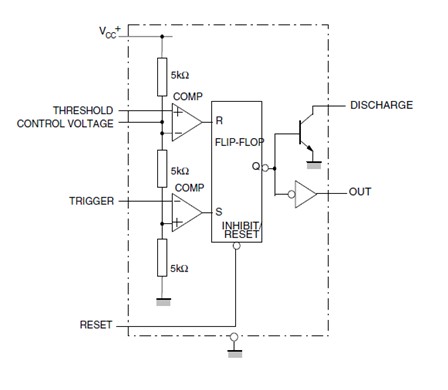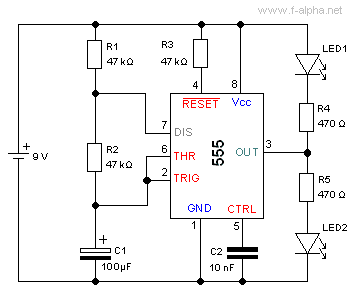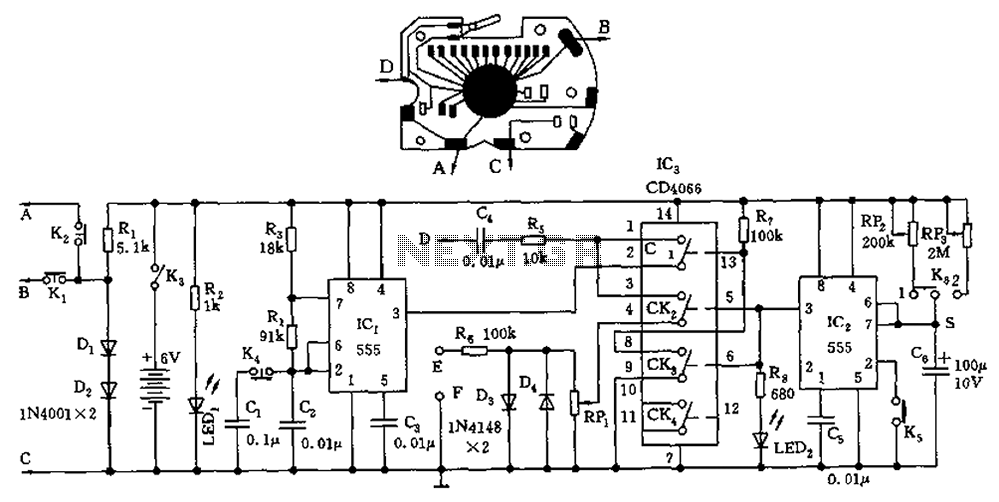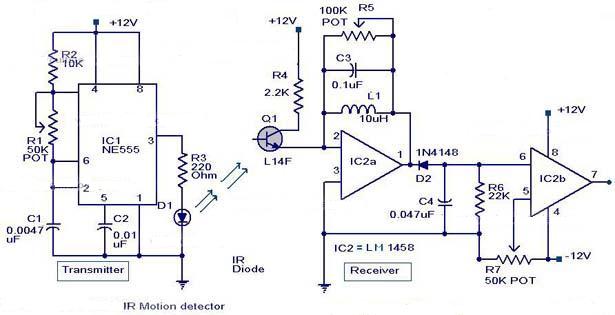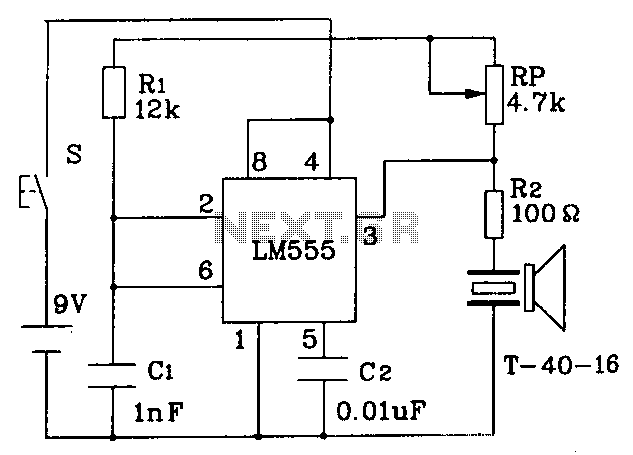
Non-standard 555 Astable Multivibrator

A square wave generator with a variable frequency and a 50% duty cycle is required. While the 555 timer is a common choice, the standard astable multivibrator configuration alters the duty cycle when the frequency is adjusted. A circuit found in an old "IC 555 Projects" book claims to maintain a variable frequency with a constant 50% duty cycle. Additional modifications include decoupling the power rails and connecting pin 5 (the control pin) to ground with a 0.1 µF capacitor, which is often recommended when not in use. The intended application is a stroboscope capable of operating at audio frequencies, with one potentiometer controlling the frequency and another adjusting the duty cycle. The output square wave from the 555 timer will be sent through an integrator to generate a triangle wave, followed by a comparator to independently adjust the duty cycle from the frequency. Probing the voltage on the capacitor at pins 2 and 6 should reveal a sawtooth waveform oscillating between 1/3 and 2/3 of the supply voltage. It is essential to ensure the capacitor value is sufficiently large to prevent distortion from the probe capacitance. An issue may arise with the LED loading the output; thus, a high-value resistor should be placed in series with the LED to limit current, or a high-impedance buffer, such as an operational amplifier, should be used between the 555 timer and the LED. The observed output frequency is approximately 6 kHz, with a timebase of 50 µs and a waveform period of about 3.2 divisions, calculated as 6250 Hz. However, there are concerns regarding the circuit's operation, as the capacitor appears to charge more slowly than it discharges. Questions arise about the supply voltage and voltage scaling across traces. The output pin voltage should fluctuate between 0 and Vcc as expected. Using the CMOS version of the 555 timer is suggested due to its rail-to-rail output and balanced source and sink capabilities. Alternatively, a 10 kΩ or higher resistor could be connected to pin 7 instead of pin 3, with a 470 Ω to 1 kΩ resistor from pin 7 to the supply to alleviate loading issues. The bipolar 555 timer has a poorly defined high output voltage, which is load-dependent. A robust transistor should be used for both pins 3 and 7, necessitating active pull-up for the circuit. The capacitor's charging and discharging times should be equal as they pass through the same resistor, but discrepancies have been noted. The supply voltage is 5V, and the output pin ranges from 0 to 3.6V, with the capacitor charging from 1.8V to 3.5V. A previously used capacitor was found to be 65.1 nF, which deviates significantly from its stated value of 473 nF.
The schematic for this square wave generator can be designed using a 555 timer in a modified astable configuration to achieve a 50% duty cycle. The circuit will include the 555 timer IC, a timing capacitor (C1), and two timing resistors (R1 and R2). The values of R1 and R2 must be selected such that their ratio maintains the duty cycle at 50%, which can be achieved by setting R1 equal to R2. The control pin (pin 5) will be connected to ground through a 0.1 µF capacitor for stability.
To create the triangle wave, the output from the 555 timer (pin 3) will be fed into an integrator circuit composed of an operational amplifier configured with a feedback capacitor (C2) and a resistor (R3) to set the time constant. The output of the integrator will then be connected to a comparator circuit, which will allow for independent duty cycle adjustment.
The output from the comparator can be used to drive an LED or other load. A current-limiting resistor (R4) should be placed in series with the LED to prevent excessive current draw from the output of the 555 timer. An operational amplifier can also be included as a buffer to isolate the LED from the timing circuit, ensuring that the timing capacitor charges and discharges correctly without being affected by the LED load.
For troubleshooting, it is crucial to monitor the voltage across the timing capacitor at pins 2 and 6, observing the expected sawtooth waveform. Any discrepancies in the charge and discharge times may indicate issues with component values or connections. The use of a CMOS version of the 555 timer is recommended for improved performance, particularly in applications requiring precise timing and consistent output levels. Adjustments to the resistor values and capacitor types may be necessary to achieve the desired frequency and duty cycle characteristics.I need to make a square-wave with variable frequency, but 50% duty cycle. The 555 timer seemed like a good idea, but with the normal astable multivibrator circuit you see everywhere, changing the frequency always ends up changing the duty cycle a bit. However, In my 20 year old "IC 555 Projects" book I found a circuit which i t specifically states has a variable frequency but 50% duty cycle. Not shown on the diagram is my decoupling of the power rails, and my decoupling of pin 5 (the control pin) to ground with a 0. 1uf capacitor (this is often recommended if you are not using it). The ultimate plan is a stroboscope that can go well into audio frequencies with one pot controlling frequency and another controlling duty cycle.
I will send the square wave from the 555 through an integrator, producing a triangle wave, then stick that through a comparator so I can vary the duty cycle completely independently of the frequency (which doesn`t seem possible with the 555 by itself). You can further investigate what is happening by probing the voltage on the capacitor, at pins 2 & 6.
You should see a sawtooth moving between 1/3 and 2/3 of the supply voltage. (Make sure the capacitor value is large enough that the probe capacitance does not distort the circuit. ) You may also have a problem with the LED loading the output down too much. Remember the output is providing current to charge up the timing capacitor, and if you make it also drive the LED you might overburden it.
Put a high value resistor in series with the LED to limit the current, or put a high impedance buffer like an op amp between the 555 and the LED. However, from the scope trace, it comes out as about 6 KHz. The timebase is 50us, and the period of the waveform is about 3. 2 divisions 1/(3. 2* 50x10-6) = 6250 Hz. Clearly you have a problem with the operation of the circuit as the capacitor is taking much longer to charge up than to discharge.
We need to ask why that might be I don`t immediately know, but something is clearly wrong there. What is the supply voltage to the circuit Also what is the voltage scale on the various traces Is the output pin voltage changing between 0 and Vcc as you would expect Try using the CMOS version of the 555. It has the advantage of a rail to rail output at low currents, and at least has equal source and sink capability.
Otherwise use a 10k or higher resistor and connect it to pin 7 instead of 3, and use a 470R to 1k resistor from 7 to the supply. That should help with loading. The big problem with the bipolar 555 is the high output voltage is not well defined, being rather load dependent.
Sink is a beefy transistor for both pin 3 and 7 ( they are the same size transistor on the die and are driven the same) so you definitely need some active pull up to the circuit. Better is to have the load be switched to ground rather than source current. Clearly you have a problem with the operation of the circuit as the capacitor is taking much longer to charge up than to discharge.
We need to ask why that might be I don`t immediately know, but something is clearly wrong there. What is the supply voltage to the circuit Also what is the voltage scale on the various traces Is the output pin voltage changing between 0 and Vcc as you would expect The vertical scale on all those pictures is 0. 2V/Div, but accounting for the x10 probes I`m using, it`s 2V/Div. The trace is slightly too high in those pics. I`m supplying 5V to the circuit and the output pin is going between 0 and 3. 6V. The Capacitor charge seems to be going from 1. 8V to 3. 5V. Since the capacitor is supposed to be charging and discharging through the same resistor, it`s odd that the times are different.
I`ve just changed the capacitor to an "identical" ceramic disc capacitor, and realized that the one I was using was 65. 1nf which is 38% off from its stated value of 473nf 🔗 External reference
The schematic for this square wave generator can be designed using a 555 timer in a modified astable configuration to achieve a 50% duty cycle. The circuit will include the 555 timer IC, a timing capacitor (C1), and two timing resistors (R1 and R2). The values of R1 and R2 must be selected such that their ratio maintains the duty cycle at 50%, which can be achieved by setting R1 equal to R2. The control pin (pin 5) will be connected to ground through a 0.1 µF capacitor for stability.
To create the triangle wave, the output from the 555 timer (pin 3) will be fed into an integrator circuit composed of an operational amplifier configured with a feedback capacitor (C2) and a resistor (R3) to set the time constant. The output of the integrator will then be connected to a comparator circuit, which will allow for independent duty cycle adjustment.
The output from the comparator can be used to drive an LED or other load. A current-limiting resistor (R4) should be placed in series with the LED to prevent excessive current draw from the output of the 555 timer. An operational amplifier can also be included as a buffer to isolate the LED from the timing circuit, ensuring that the timing capacitor charges and discharges correctly without being affected by the LED load.
For troubleshooting, it is crucial to monitor the voltage across the timing capacitor at pins 2 and 6, observing the expected sawtooth waveform. Any discrepancies in the charge and discharge times may indicate issues with component values or connections. The use of a CMOS version of the 555 timer is recommended for improved performance, particularly in applications requiring precise timing and consistent output levels. Adjustments to the resistor values and capacitor types may be necessary to achieve the desired frequency and duty cycle characteristics.I need to make a square-wave with variable frequency, but 50% duty cycle. The 555 timer seemed like a good idea, but with the normal astable multivibrator circuit you see everywhere, changing the frequency always ends up changing the duty cycle a bit. However, In my 20 year old "IC 555 Projects" book I found a circuit which i t specifically states has a variable frequency but 50% duty cycle. Not shown on the diagram is my decoupling of the power rails, and my decoupling of pin 5 (the control pin) to ground with a 0. 1uf capacitor (this is often recommended if you are not using it). The ultimate plan is a stroboscope that can go well into audio frequencies with one pot controlling frequency and another controlling duty cycle.
I will send the square wave from the 555 through an integrator, producing a triangle wave, then stick that through a comparator so I can vary the duty cycle completely independently of the frequency (which doesn`t seem possible with the 555 by itself). You can further investigate what is happening by probing the voltage on the capacitor, at pins 2 & 6.
You should see a sawtooth moving between 1/3 and 2/3 of the supply voltage. (Make sure the capacitor value is large enough that the probe capacitance does not distort the circuit. ) You may also have a problem with the LED loading the output down too much. Remember the output is providing current to charge up the timing capacitor, and if you make it also drive the LED you might overburden it.
Put a high value resistor in series with the LED to limit the current, or put a high impedance buffer like an op amp between the 555 and the LED. However, from the scope trace, it comes out as about 6 KHz. The timebase is 50us, and the period of the waveform is about 3. 2 divisions 1/(3. 2* 50x10-6) = 6250 Hz. Clearly you have a problem with the operation of the circuit as the capacitor is taking much longer to charge up than to discharge.
We need to ask why that might be I don`t immediately know, but something is clearly wrong there. What is the supply voltage to the circuit Also what is the voltage scale on the various traces Is the output pin voltage changing between 0 and Vcc as you would expect Try using the CMOS version of the 555. It has the advantage of a rail to rail output at low currents, and at least has equal source and sink capability.
Otherwise use a 10k or higher resistor and connect it to pin 7 instead of 3, and use a 470R to 1k resistor from 7 to the supply. That should help with loading. The big problem with the bipolar 555 is the high output voltage is not well defined, being rather load dependent.
Sink is a beefy transistor for both pin 3 and 7 ( they are the same size transistor on the die and are driven the same) so you definitely need some active pull up to the circuit. Better is to have the load be switched to ground rather than source current. Clearly you have a problem with the operation of the circuit as the capacitor is taking much longer to charge up than to discharge.
We need to ask why that might be I don`t immediately know, but something is clearly wrong there. What is the supply voltage to the circuit Also what is the voltage scale on the various traces Is the output pin voltage changing between 0 and Vcc as you would expect The vertical scale on all those pictures is 0. 2V/Div, but accounting for the x10 probes I`m using, it`s 2V/Div. The trace is slightly too high in those pics. I`m supplying 5V to the circuit and the output pin is going between 0 and 3. 6V. The Capacitor charge seems to be going from 1. 8V to 3. 5V. Since the capacitor is supposed to be charging and discharging through the same resistor, it`s odd that the times are different.
I`ve just changed the capacitor to an "identical" ceramic disc capacitor, and realized that the one I was using was 65. 1nf which is 38% off from its stated value of 473nf 🔗 External reference
